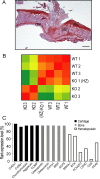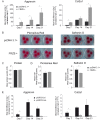Tight regulation of wingless-type signaling in the articular cartilage - subchondral bone biomechanical unit: transcriptomics in Frzb-knockout mice
- PMID: 22264237
- PMCID: PMC3392806
- DOI: 10.1186/ar3695
Tight regulation of wingless-type signaling in the articular cartilage - subchondral bone biomechanical unit: transcriptomics in Frzb-knockout mice
Abstract
Introduction: The aim of this research was to study molecular changes in the articular cartilage and subchondral bone of the tibial plateau from mice deficient in frizzled-related protein (Frzb) compared to wild-type mice by transcriptome analysis.
Methods: Gene-expression analysis of the articular cartilage and subchondral bone of three wild-type and three Frzb-/- mice was performed by microarray. Data from three wild-type and two Frzb-/- samples could be used for pathway analysis of differentially expressed genes and were explored with PANTHER, DAVID and GSEA bioinformatics tools. Activation of the wingless-type (WNT) pathway was analysed using Western blot. The effects of Frzb gain and loss of function on chondrogenesis and cell proliferation was examined using ATDC5 micro-masses and mouse ribcage chondrocytes.
Results: Extracellular matrix-associated integrin and cadherin pathways, as well as WNT pathway genes were up-regulated in Frzb-/- samples. Several WNT receptors, target genes and other antagonists were up-regulated, but no difference in active β-catenin was found. Analysis of ATDC5 cell micro-masses overexpressing FRZB indicated an up-regulation of aggrecan and Col2a1, and down-regulation of molecules related to damage and repair in cartilage, Col3a1 and Col5a1. Silencing of Frzb resulted in down-regulation of aggrecan and Col2a1. Pathways associated with cell cycle were down-regulated in this transcriptome analysis. Ribcage chondrocytes derived from Frzb-/- mice showed decreased proliferation compared to wild-type cells.
Conclusions: Our analysis provides evidence for tight regulation of WNT signalling, shifts in extracellular matrix components and effects on cell proliferation and differentiation in the articular cartilage - subchondral bone unit in Frzb-/- mice. These data further support an important role for FRZB in joint homeostasis and highlight the complex biology of WNT signaling in the joint.
Figures




Similar articles
-
Protective role of frizzled-related protein B on matrix metalloproteinase induction in mouse chondrocytes.Arthritis Res Ther. 2014 Jul 1;16(4):R137. doi: 10.1186/ar4599. Arthritis Res Ther. 2014. PMID: 24984954 Free PMC article.
-
Molecular differentiation between osteophytic and articular cartilage--clues for a transient and permanent chondrocyte phenotype.Osteoarthritis Cartilage. 2012 Feb;20(2):162-71. doi: 10.1016/j.joca.2011.12.004. Epub 2011 Dec 13. Osteoarthritis Cartilage. 2012. PMID: 22209871
-
GREM1, FRZB and DKK1 mRNA levels correlate with osteoarthritis and are regulated by osteoarthritis-associated factors.Arthritis Res Ther. 2013 Sep 19;15(5):R126. doi: 10.1186/ar4306. Arthritis Res Ther. 2013. PMID: 24286177 Free PMC article.
-
The Key Role of Canonical Wnt/β-catenin Signaling in Cartilage Chondrocytes.Curr Drug Targets. 2016;17(4):475-84. doi: 10.2174/1389450116666150825112623. Curr Drug Targets. 2016. PMID: 26302804 Review.
-
Mechanisms of synovial joint and articular cartilage development.Cell Mol Life Sci. 2019 Oct;76(20):3939-3952. doi: 10.1007/s00018-019-03191-5. Epub 2019 Jun 14. Cell Mol Life Sci. 2019. PMID: 31201464 Free PMC article. Review.
Cited by
-
Osteoarthritis pathogenesis: a review of molecular mechanisms.Calcif Tissue Int. 2014 Dec;95(6):495-505. doi: 10.1007/s00223-014-9917-9. Epub 2014 Oct 14. Calcif Tissue Int. 2014. PMID: 25311420 Free PMC article. Review.
-
An integrated in silico-in vitro approach for identifying therapeutic targets against osteoarthritis.BMC Biol. 2022 Nov 9;20(1):253. doi: 10.1186/s12915-022-01451-8. BMC Biol. 2022. PMID: 36352408 Free PMC article.
-
Roles of Wnt pathway genes wls, wnt9a, wnt5b, frzb and gpc4 in regulating convergent-extension during zebrafish palate morphogenesis.Development. 2016 Jul 15;143(14):2541-7. doi: 10.1242/dev.137000. Epub 2016 Jun 10. Development. 2016. PMID: 27287801 Free PMC article.
-
A pilot study of peripheral blood DNA methylation models as predictors of knee osteoarthritis radiographic progression: data from the Osteoarthritis Initiative (OAI).Sci Rep. 2019 Nov 14;9(1):16880. doi: 10.1038/s41598-019-53298-9. Sci Rep. 2019. PMID: 31727952 Free PMC article.
-
Signaling pathways in cartilage repair.Int J Mol Sci. 2014 May 15;15(5):8667-98. doi: 10.3390/ijms15058667. Int J Mol Sci. 2014. PMID: 24837833 Free PMC article. Review.
References
Publication types
MeSH terms
Substances
Associated data
- Actions
LinkOut - more resources
Full Text Sources
Other Literature Sources
Molecular Biology Databases
Miscellaneous

